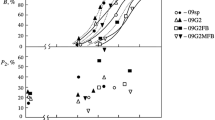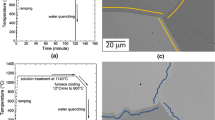Conclusions
-
1.
The change from the ductile to the brittle condition in coarse-grained samples of silicon iron involves an increase of resistance to plastic deformation by slip and the development of a complex twinning process.
-
2.
Twin-twin and twin-grain boundary intersections create stress concentrators that favor the propagation of microcracks.
-
3.
Brittle fracture at temperatures above the critical embrittlement range is due to the development of stresses as the result of plastic deformation that conform with Griffiths' conditions for the formation and propagation of cracks.
Similar content being viewed by others
Literature cited
C. Barrettt, Structure of Metals [Russian translation], Metallurgizdat, Moscow (1958).
D. Hull, Acta Met.,9, No. 3 (1961).
R. Honda, J. Physical Soc. Japan,16, No. 7 (1961).
Atomic Mechanism of Failure [Russian translation], Metallurgizdat, Moscow (1963).
A. Tetelman, Acta Met.,12, No. 3 (1964).
Additional information
Central Scientific Research Institute of Ferrous Metallurgy. Translated from Metallovedenie i Termicheskaya Obrabotka Metallov, No. 9, pp. 38, 43–44, September, 1969.
Rights and permissions
About this article
Cite this article
Gaiduchenya, V.F., Lebedev, D.V. & Molotilov, B.V. Brittle fracture of coarse-grained silicon iron. Met Sci Heat Treat 11, 712–714 (1969). https://doi.org/10.1007/BF00653166
Issue Date:
DOI: https://doi.org/10.1007/BF00653166




